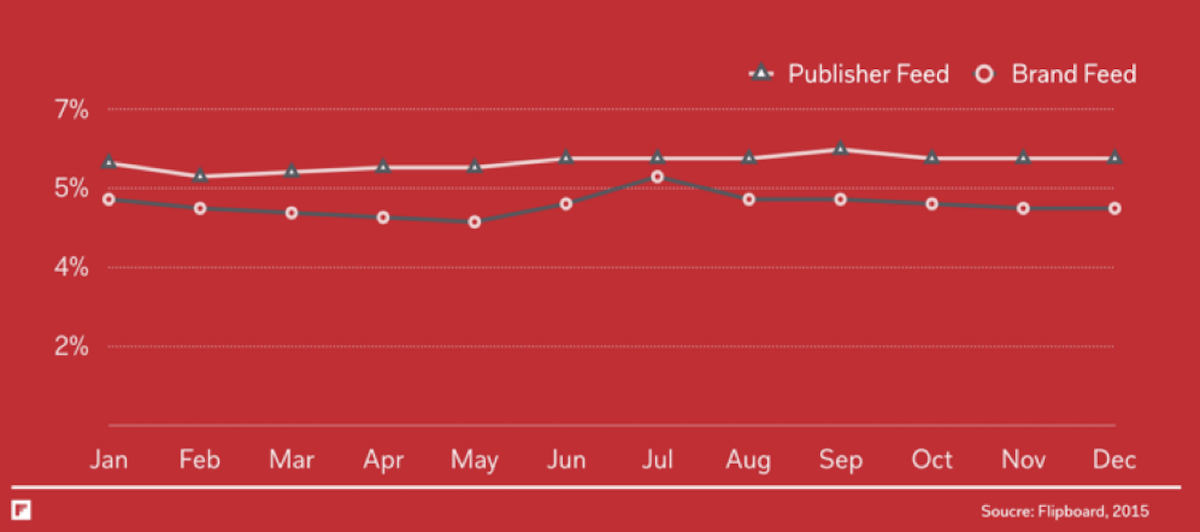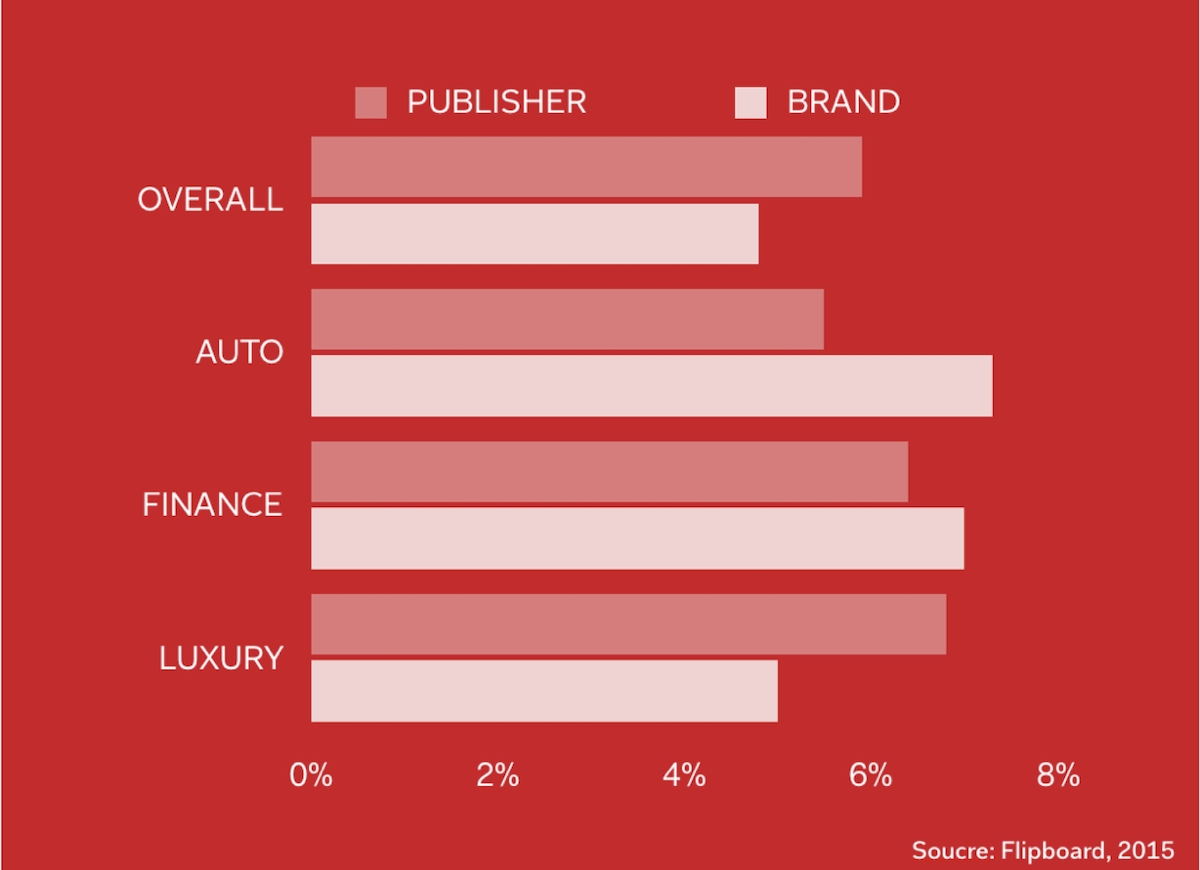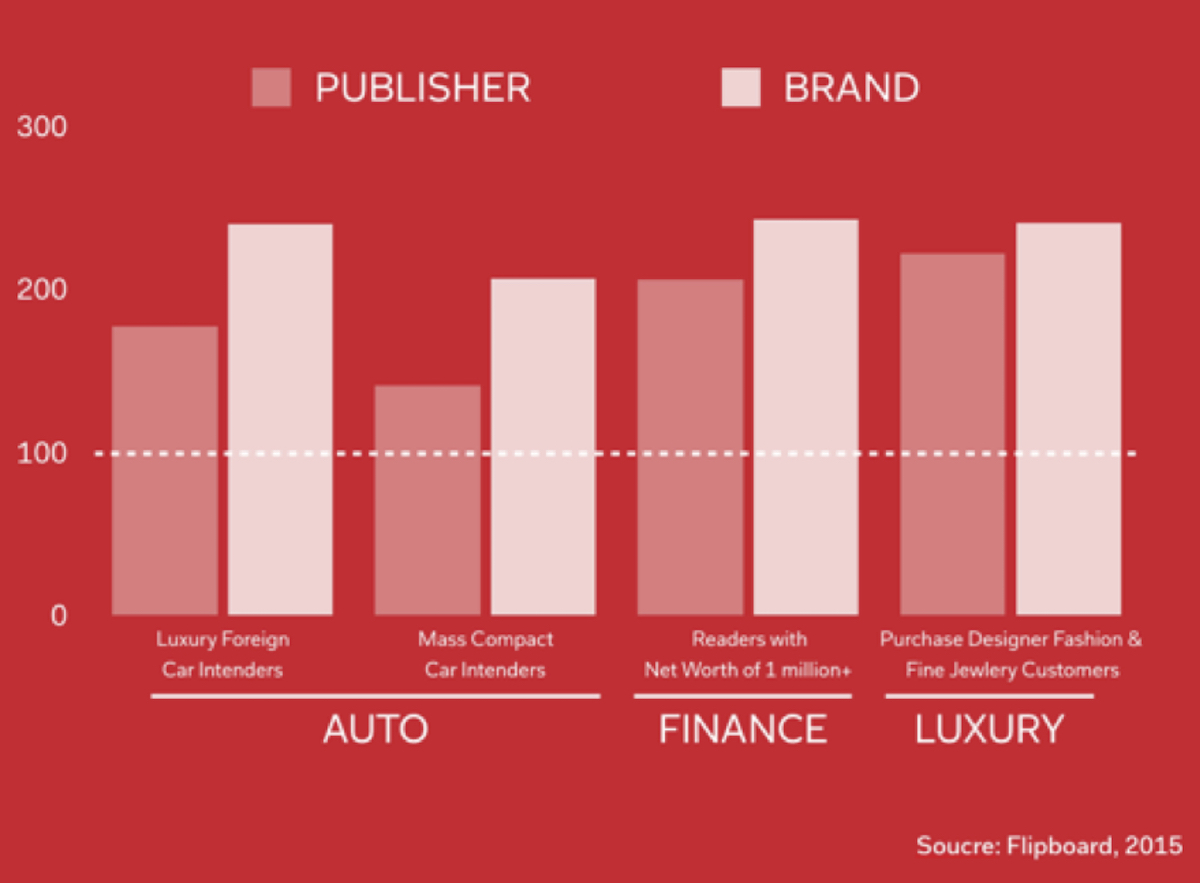 More and more, brands aspire to be publishers. They seek to produce high quality content that engages readers in meaningful ways. Promoted content, however, presents a dual challenge for brands: how to engage readers like a publisher while still delivering impact like an advertiser. While this is not an easy feat, brands should not shy away from this challenge.
Flipboard readers are highly engaged, consuming more than 8 billion articles a year from both brands and publishers alike. But for brands to engage readers like publishers do, there are three factors that marketers should take into consideration:
1) Content Environment: Leveling the playing field helps brands to engage like publishers. On Flipboard, we provide consistent native formats with similar visual elements for both brands and publisher content, with the exception of a promoted label for sponsored content. Both brand and publisher content is categorized by interest and delivered to readers who share this affinity.
More so, readers have an equal opportunity to engage with content from the most relevant sources, and as a result, we see that engagement rates are similar for brands and publishers. On average, the engagement rate for promoted content is 4 percent—much higher than native content on other platforms—while the engagement rate for publisher content on Flipboard is a bit higher at 6 percent*. Although many readers are indifferent to sponsored content, others remain somewhat cautious about engaging with content labeled as promoted. Nonetheless, readers are interested in what brands have to say.
2) Content Quality: Once readers click on an article, they spend about the same amount of time reading promoted content as they would reading publisher content. In fact, on average, the difference in time spent is only 5 percent. This indicates that brands are producing thoughtful content that resonates with readers. Whether it’s thought-leadership pieces, how-to articles, or insight into how their favorite brands operate, users are diving deep into promoted content.
[caption id="attachment_31682" align="aligncenter" width="1200"]
More and more, brands aspire to be publishers. They seek to produce high quality content that engages readers in meaningful ways. Promoted content, however, presents a dual challenge for brands: how to engage readers like a publisher while still delivering impact like an advertiser. While this is not an easy feat, brands should not shy away from this challenge.
Flipboard readers are highly engaged, consuming more than 8 billion articles a year from both brands and publishers alike. But for brands to engage readers like publishers do, there are three factors that marketers should take into consideration:
1) Content Environment: Leveling the playing field helps brands to engage like publishers. On Flipboard, we provide consistent native formats with similar visual elements for both brands and publisher content, with the exception of a promoted label for sponsored content. Both brand and publisher content is categorized by interest and delivered to readers who share this affinity.
More so, readers have an equal opportunity to engage with content from the most relevant sources, and as a result, we see that engagement rates are similar for brands and publishers. On average, the engagement rate for promoted content is 4 percent—much higher than native content on other platforms—while the engagement rate for publisher content on Flipboard is a bit higher at 6 percent*. Although many readers are indifferent to sponsored content, others remain somewhat cautious about engaging with content labeled as promoted. Nonetheless, readers are interested in what brands have to say.
2) Content Quality: Once readers click on an article, they spend about the same amount of time reading promoted content as they would reading publisher content. In fact, on average, the difference in time spent is only 5 percent. This indicates that brands are producing thoughtful content that resonates with readers. Whether it’s thought-leadership pieces, how-to articles, or insight into how their favorite brands operate, users are diving deep into promoted content.
[caption id="attachment_31682" align="aligncenter" width="1200"] Average time spent by publisher and brand[/caption]
3) Content Affinity: Giving readers the opportunity to reach the content that matters the most to them also drives engagement. Dedicated publisher feeds and Brand Magazines provide this opportunity for enthusiasts of specific publishers and brands. When enthusiasts are flipping through dedicated feeds, we see similar engagement rates between brands and publishers—averaging 5 percent and 6 percent, respectively.
[caption id="attachment_31683" align="aligncenter" width="1200"]
Average time spent by publisher and brand[/caption]
3) Content Affinity: Giving readers the opportunity to reach the content that matters the most to them also drives engagement. Dedicated publisher feeds and Brand Magazines provide this opportunity for enthusiasts of specific publishers and brands. When enthusiasts are flipping through dedicated feeds, we see similar engagement rates between brands and publishers—averaging 5 percent and 6 percent, respectively.
[caption id="attachment_31683" align="aligncenter" width="1200"] Average engagement rate by publisher and brand feed[/caption]
In certain categories, like auto and financial services, engagement rates for branded content exceed those for publishers.
[caption id="attachment_31684" align="aligncenter" width="1200"]
Average engagement rate by publisher and brand feed[/caption]
In certain categories, like auto and financial services, engagement rates for branded content exceed those for publishers.
[caption id="attachment_31684" align="aligncenter" width="1200"] Engagement rate by publisher and brand by industry[/caption]
Reaching a High Quality Audience
While brands can engage like publishers, it’s also important to validate that they attract audiences of similar quality. One way is to compare audiences based on their propensity to purchase products in the category that they are reading about.
As it turns out, readers are equally likely to make relevant purchases whether they read promoted or publisher content. According to Datalogix, Flipboard readers of luxury content from both brands and publishers are 2x more likely to purchase designer fashion and luxury jewelry than overall mobile audiences. We see that branded content attracts a higher concentration of purchase intenders than publishers do in some categories like auto.
[caption id="attachment_31685" align="aligncenter" width="1200"]
Engagement rate by publisher and brand by industry[/caption]
Reaching a High Quality Audience
While brands can engage like publishers, it’s also important to validate that they attract audiences of similar quality. One way is to compare audiences based on their propensity to purchase products in the category that they are reading about.
As it turns out, readers are equally likely to make relevant purchases whether they read promoted or publisher content. According to Datalogix, Flipboard readers of luxury content from both brands and publishers are 2x more likely to purchase designer fashion and luxury jewelry than overall mobile audiences. We see that branded content attracts a higher concentration of purchase intenders than publishers do in some categories like auto.
[caption id="attachment_31685" align="aligncenter" width="1200"] Audience profile index[/caption]
Brands should consider three factors when creating and distributing content: the content environment on the platform, the content quality, and the audience’s affinity for that content. By addressing these considerations, brands can engage like a publisher and attract a valuable audience when they do.
~RuthZ is reading Left Brain/ Right Brain
————————————————————–
*As publisher content typically appears just once as readers flip through Flipboard, an apples-to-apples comparison with branded content requires comparing engagement rates associated with the first exposure to the content.
Audience profile index[/caption]
Brands should consider three factors when creating and distributing content: the content environment on the platform, the content quality, and the audience’s affinity for that content. By addressing these considerations, brands can engage like a publisher and attract a valuable audience when they do.
~RuthZ is reading Left Brain/ Right Brain
————————————————————–
*As publisher content typically appears just once as readers flip through Flipboard, an apples-to-apples comparison with branded content requires comparing engagement rates associated with the first exposure to the content.
